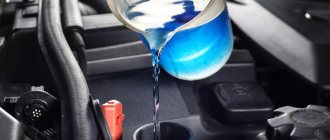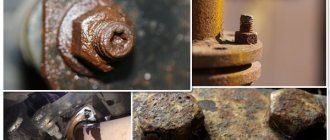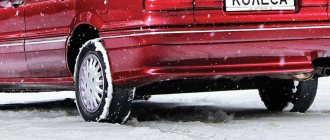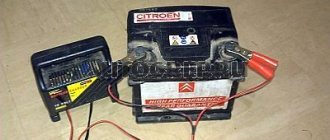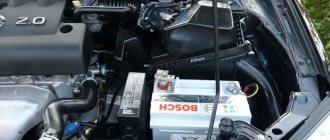- home
- car battery
- …
I often receive messages on my blog about battery maintenance, in particular, is it necessary (and is it possible) to add distilled water inside? How much is needed? Why is this done, and will it cause any harm? I have already written several articles on this subject, but I have not examined this issue in detail. Today I want to close this gap, as usual there will be a video version at the end. Separately, I will focus on the maintenance-free battery. So read and look, it’s definitely useful information...
The water in the battery is everything to us! Without it, it will not work normally, all because it is part of an electrochemical fluid, simply an electrolyte. However, under the influence of temperature, it can evaporate from there.
Electrolyte
As you and I know, the electrolyte (inside the battery) consists of two main components:
- This is sulfuric acid. Its approximately 35% of the total volume
- Distilled water. Its approximately 65%
When these two substances are mixed, the electrolyte needed for work is obtained, with a density of 1.27 g/cm3. It is not recommended to add more than 35% acid; if you raise the density to 1.3 - 1.4 g/cm3, then at this concentration the lead plates will suffer and may collapse prematurely.
However, it is also not recommended to pour less acid; a reduced density of 1.2 - 1.23 g/cm3 can contribute to the freezing of the electrolyte at extremely negative temperatures (-25, -35 degrees).
That is, this density has been verified by many experiments and is a reference; it is worth noting that in the north up to 1.29 g/cm3 is allowed
Modern active vehicle safety systems
Active vehicle safety systems are aimed at preventing emergency situations and preventing accidents. The vehicle's electronic control unit is responsible for monitoring active safety systems in real time.
1.Anti-lock braking system or ABS
The car's wheels may become blocked during sudden braking and high speed driving. Controllability tends to zero and the likelihood of an accident increases sharply.
The anti-lock braking system forcibly unlocks the wheels and returns control of the car. A characteristic sign of ABS operation is the beating of the brake pedal. To increase the effectiveness of the anti-lock braking system when braking, depress the brake pedal as hard as possible.
The system avoids slipping and makes it easier to climb uphill on slippery road surfaces.
The system is aimed at ensuring vehicle stability when driving on the road. Efficient and reliable in operation.
4.Brake force distribution system or EBD
Allows you to prevent the car from skidding when braking due to the uniform distribution of braking force between the front and rear wheels.
5.Differential lock
The differential transmits torque from the gearbox to the drive wheels. The lock allows for uniform transmission of force, even if one of the drive wheels has insufficient traction with the road surface.
6.Assistance system for ascent and descent
Ensures that optimal speed is maintained when descending or ascending a mountain. If necessary, brakes one or more wheels.
7.Parking sensors
A system that simplifies parking a car and reduces the risk of collision with other vehicles when maneuvering in a parking lot. A special electronic display indicates the distance to the obstacle.
8.Preventive emergency braking system
Capable of operating at speeds over 30 km/h. The electronic system automatically monitors the distance between cars. If the vehicle ahead comes to a sudden stop and there is no reaction from the driver, the system automatically slows down the car.
Modern car manufacturers pay a lot of attention to active and passive safety systems. They are constantly working on their improvement and reliability.
Water inside the battery
How we figured out water AJ - 65%! But it is not simple (from the tap) , but distilled without any impurities (this is necessary for many reasons, if only because the resistance inside decreases, there is no sediment on the plates, etc.).
But its level is not constant. As is known from high temperatures in the engine compartment, from charging the generator (sometimes overcharging ), water can evaporate from the cans, and the electrolyte level drops.
Sulfuric acid does not evaporate, and therefore its concentration begins to increase; this is bad for the battery in several ways:
- High density negatively affects the plates, destroying them
- The level drops, which means the plates are exposed, thereby reducing the battery capacity and it is not able to start your car.
- At high acid concentrations, sulfation of the plates
To avoid this, you must replenish it - add water inside the battery to the required minimum.
How to add water to the battery?
First, let's look at the serviceable option - when there are plugs on top of the battery. Everything is elementary here:
First , you need to buy distilled water in a store or make it yourself at home .
Second , just unscrew the plugs on top and look at the plates. If they are bare, the electrolyte level is lower, you need to add so that the water covers them. I’ll tell you how much to pour below.
Third , after adding it, put it on charge; you can use automatic chargers
As you can see, everything is elementary - there are no problems.
Maintenance free battery
But if you take a maintenance-free battery (for example, BOSCH, VARTA, MUTLU and many others), then you won’t be able to add it here so easily. The design does not provide for adding water inside, that is, you will have to “chemically” it.
To be fair, it is worth noting that often maintenance-free batteries are made using calcium technology and their water loss is very small. However, after 4–5 years the level still drops and it is advisable to bring it to normal
BY THE WAY - many of these batteries are handed over to specialized stores when they no longer start the car and they buy new ones. BUT NOT MANY people know that you just need to add water there and then performance will be restored.
HOW TO ADD, STEP-BY-STEP INSTRUCTIONS:
- First, determine the electrolyte level. Lightly shake the battery left and right, if there is a minimum level, then you should add water. If there is a feeling that there is enough of it there, then perhaps water will not help you (maybe you have shedding or sulfation)
- We determine where your plates are located (at what height). If the battery is transparent (has a white casing, like BOSCH's), you can illuminate it with a flashlight. But if the body is black, then it won’t work out that easily, you have to figure it out “by eye”
- We retreat from the plates approximately 1.5 - 2 cm upward. We take a 2-3 mm drill and drill small holes.
- Take distilled water and a syringe with a needle. Fill the syringe and pour it into the battery through the holes
- It is worth adding before liquid begins to ooze through the holes.
- Then we put the battery on its side and solder the holes with a regular soldering iron.
- Then we just charge
You have to “collective farm”, there is no other way. Some people drill holes from the top, but this way it is impossible to control the level (and you also cannot overfill).
What happens if you fill in the wrong liquid?
If you use ordinary untreated water, deposits can quickly form on the electrodes. Because of them, the plates may collapse.
Poor quality water leads to deterioration of electrical conductivity. The resulting sediment subsequently leads to rapid battery discharge. The result may be its complete failure.
If you add an inappropriate component, it is possible:
- accelerating the process of battery loss of water included in the electrolyte;
- increasing the resistance of battery plates;
- increasing the density of the electrolyte itself.
Even a single use of undistilled water can lead to sedimentation. As a result, the system will be short circuited.
How much water should I add to the jars?
Another important condition. Some batteries have a special level (usually on the side of the case) to which you should add water (you cannot overfill).
However, a large number of batteries do not have this level, so how much should you pour?
ONE very simple rule. The plates must be covered with electrolyte by 1 - 1.5 cm (measured with special measuring tubes). At this level, a density of 1.27 g/cm3 is obtained
You shouldn’t pour more, otherwise the density will drop to 1.20 - 1.24 g/cm3 and there is a high probability that the battery may freeze in winter.
Now let's watch a small but useful video.
This is where I end, I think my article was useful to you. Sincerely yours, AUTOBLOGGER
Similar news
- Is it possible to charge a maintenance-free battery? A regular charger...
- Black or cloudy electrolyte in the battery. What to do? Let's sort it out...
- The car battery is frozen. Can this happen and what...
Add a comment Cancel reply
What cannot be replaced?
Neither ordinary tap water nor tap water purified with a simple filter can be used as battery fill. Also, you should not replace the distillate with unfiltered rainfall and melt water.
Rainfall collected in a city where industrial enterprises operate is not suitable. The reasons for the impossibility of using these types of water lie in the following:
- tap water contains many salts that are harmful to batteries;
- tap water passed through a filter contains fewer impurities, but the concentration of dissolved salts is still high;
- In unfiltered rainfall and urban melted snow there are many chemical compounds that got there from the atmosphere polluted by industry.
Any unpurified solutions contain chemical components that can cause car batteries to fail prematurely.
Reference. Do not mix boiled water with electrolyte. Although this composition becomes less rigid, a salt precipitate is formed in it. Boiled liquid produces even more impurities that negatively affect the operation of the battery.



